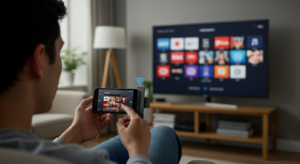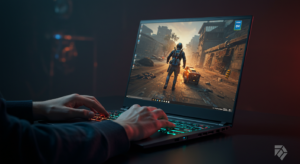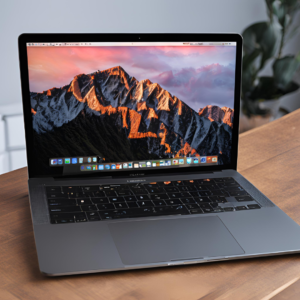If you’re shopping for a portable computer in Australia, you’ll often see the terms notebook and laptop used interchangeably.
But they aren’t exactly the same.
Understanding the difference can help you make a better buying decision, especially when considering performance, portability, and price.
This guide breaks down the key distinctions in clear terms to help you decide whether a notebook or laptop is right for you in 2025.
What Defines a Laptop and a Notebook?
Laptop:
A laptop is a portable computer with performance levels comparable to a desktop. It usually features a full-sized keyboard, multiple ports, and powerful processors.
Notebook:
A notebook is a lighter, slimmer version of a laptop. It sacrifices some performance for portability. Most notebooks use energy-efficient chips, have fewer ports, and come with smaller screens.
Over time, the gap between the two has narrowed. Many modern notebooks are powerful enough for most daily tasks. However, laptops still hold the edge when it comes to running demanding software, multitasking, or gaming.
In Australia, retailers may use these terms interchangeably, but specs tell the real story. Always compare RAM, CPU, storage, and battery specs to make an informed choice.
Key Differences Between Notebooks and Laptops
Size and Portability
Notebooks are generally more compact, often with screen sizes between 11 to 14 inches.
Laptops range from 14 to 17 inches, with thicker chassis to accommodate more hardware.
If you’re always on the move—say, commuting daily or travelling frequently—a notebook’s smaller size and lighter build make it ideal.
Laptops are heavier, but they offer better screen real estate and internal cooling systems. This makes them better suited for longer work sessions or multimedia tasks.
For Australians working remotely or studying in cafés, the difference in portability can impact daily comfort and workflow efficiency.
Performance and Power
Laptops are designed for performance.
They often include faster CPUs (like Intel Core i7 or AMD Ryzen 7), dedicated GPUs, and higher RAM options. These features make them ideal for video editing, coding, and multitasking.
Notebooks focus on everyday use: web browsing, document editing, and video streaming. Most run on energy-efficient CPUs (like Intel Core i3 or M-series chips) and may have integrated graphics.
In short, notebooks handle light workloads well.
But for power users—gamers, designers, developers—laptops are the better choice.
Battery Life
Notebooks generally have longer battery life.
Because they use low-power components and smaller screens, some can last up to 12 hours or more on a single charge.
Laptops consume more energy, especially if equipped with high-performance processors or discrete graphics.
On average, laptops offer 6–8 hours of battery life, depending on usage.
For students or mobile professionals, battery longevity is key. If you’re spending hours away from power outlets, notebooks have the upper hand.
Use Cases: Which One Suits You Best?
Students and Light Users
Notebooks are well-suited to students and casual users.
They’re lightweight, easy to carry around campus, and sufficient for tasks like taking notes, researching, writing essays, and attending Zoom lectures.
The battery life is usually enough to last through a full day of classes or library sessions.
Also, many notebooks are more affordable, which is ideal for budget-conscious students.
Unless you’re studying a subject that requires high-end software (like engineering or design), a notebook covers all the basics.
Business and Power Users
Professionals who multitask or use resource-heavy software benefit from a laptop.
Tasks like video editing, data analysis, and software development demand better processing power and more RAM.
Laptops can also connect to more peripherals, like external monitors or projectors, which suits office setups.
In hybrid work environments across Australia, a capable laptop ensures smooth performance at home, on the go, or in the office.
Pricing Comparison in Australia
Generally, notebooks cost less.
You’ll find decent notebooks in Australia starting around AUD $500–$800.
Laptops with higher specs typically start from AUD $1,000 and go well beyond AUD $3,000 depending on brand and configuration.
Keep in mind: price often reflects performance. Paying more can give you better long-term value if your usage includes demanding applications or future upgrades.
It’s also worth checking for education or business discounts offered by major Australian retailers.
About Hire Laptops in Australia
If you need a device for a short-term project, event, or trial period, hiring a laptop or notebook can be a practical and budget-friendly solution.
Laptop hire services in Australia offer a wide range of models—both high-performance laptops and lightweight notebooks—suited for business events, education, remote work, or travel.
Benefits of hiring include:
- Cost-efficiency: No upfront investment, especially useful for short-term needs.
- Flexibility: Choose the exact model and spec that suits your task.
- Scalability: Rent multiple devices for corporate events or training sessions.
- Support and setup: Many providers offer pre-configuration, delivery, and on-site tech support.
Whether you’re hosting a conference in Sydney, training staff in Melbourne, or testing devices in Brisbane, local laptop hire companies can deliver nationwide.
Hiring is ideal if you’re unsure whether to commit to a laptop or notebook purchase—or simply need tech on-demand.
Look for providers with transparent pricing, up-to-date inventory, and responsive support to get the most value.
Final Thoughts: Laptop or Notebook in 2025?
Choose a notebook if:
- You want something lightweight and affordable.
- Your tasks are basic—like browsing, writing, or streaming.
- You need all-day battery life.
Choose a laptop if:
- You need more power for work, design, or gaming.
- You’re using it for professional or creative workloads.
- You want more ports, larger screens, and upgrade options.
Both can be right, depending on how you work or study.
Read the specs. Consider your needs. Buy accordingly.


